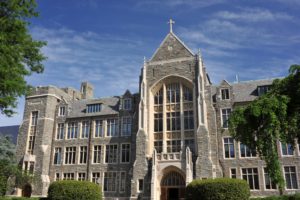An increasing number of public and private universities are committing to meet aggressive decarbonization goals—often net zero carbon emissions before 2050. While these pledges are bold and commendable, achieving these targets through status-quo campus energy operations are often difficult for many universities. These targets are set in the wake of the increasing unreliability of government funding—a result of constrained state and local budgets—and a growing backlog of deferred maintenance, which diminishes the efficiency of university energy consumption.
Many higher education institutions are partnering with the private sector through energy public-private partnerships (P3s) to finance and deliver modernization projects critical to meeting these decarbonization goals and addressing deferred maintenance needs. Pursuing P3s allows universities to leverage private sector expertise, innovation and capital to implement decarbonization efforts, address critical deferred maintenance needs, reduce energy costs, and achieve resiliency goals, all while preserving limited debt capacity for academic projects.
University Budget Report Card
State funding continues a downward trend while the pressure to limit tuition increases is simultaneously mounting. Since the Great Recession, funding for higher education has significantly decreased. In the near term, higher education institutions will remain under the sustained pressure experienced since 2008 to cut costs through innovative and creative means.
At the same time, higher education administrators are hesitant to use their limited debt capacity for nonacademic purposes. This constraint means the maintenance of campus energy infrastructure is often underfunded, accelerating the deterioration of heating, cooling, and lighting systems. The estimated deferred maintenance backlog at higher education institutions is approximately $112 billion. That deferred maintenance has created significant demand for energy projects, particularly those that support sustainability and renewable energy goals.
Energy Opportunities in Universities
The higher education sector spends over $6 billion on annual energy costs. More than 50 percent of university energy consumption costs arise from lighting, ventilation, and cooling equipment needs, making these systems the best targets for environmental savings. Students need well-lit, heated, and cooled spaces to learn and live, so finding ways to reduce the cost of utilities is imperative. It is generally estimated that most universities could save up to 30 percent on their energy bills by addressing deferred maintenance needs and pursuing cost-effective energy efficiency upgrades.
It is generally estimated that most universities could save up to 30 percent on their energy bills by addressing deferred maintenance needs and pursuing cost-effective energy efficiency upgrades
Updating energy infrastructure on university campuses is a powerful step towards goals for carbon neutrality and net zero agendas. More than 400 of the nation’s leading universities have set aggressive energy-reduction and climate action plans. To reach these goals, leading universities have developed a suite of shared energy-efficiency and renewable generation policies and initiatives, including the American College & University Presidents’ Climate Commitment (ACUPCC) and the Association for the Advancement of Sustainability in Higher Education Sustainability Tracking, Assessment & Rating System (STARS).
Net zero aims to balance the emissions produced versus those removed from the atmosphere. These lofty ambitions require public agencies and universities to commit to making every effort to reduce emissions and invest in methods to counterbalance the emissions they produce. The goal of achieving a net zero campus today becomes further challenged when considering the age of many campus energy systems.
Aging Energy Infrastructure and Workforce
The mean age of campus buildings is approximately 35.5 years, according to data produced by the U.S. Energy Information Administration. Due to aging, the resulting suboptimal energy efficiency means that buildings require higher energy consumption than they would otherwise need. In addition, most energy systems operating on university campuses today are first- or second-generation systems, which translates into increased maintenance costs and challenged decarbonization plans.
Similarly, the operational expertise to manage these facilities relies on an aging workforce. The district energy sector increasingly emphasizes apprenticeship and internship programs to recruit the next generation of operation and maintenance professionals. Institutions will need to leverage the expertise of the private sector to drive innovation and technological advancement capable of achieving net zero goals at the campus-wide level.
Improving the resiliency of utility plants is also important to universities, particularly as campuses face climate change and resulting extreme weather events, which are capable of straining and even crippling a campus’s energy infrastructure. Resiliency, redundancy, and reliability can all be addressed in partnership with a private developer through a P3 contractual framework.
Private Sector Investment and Innovation on Campus
Partnering with the private sector on energy projects can alleviate the burden on higher education administrators as they work to maximize tighter budgets, freeing them up to focus on their institution’s core mission.
P3s have emerged as a viable means of simultaneously pursuing university climate pledges and addressing deferred maintenance, as demonstrated by recent successes at Fresno State University, Eastern Michigan University, Georgetown University, and the University of Iowa.
Fresno State University Utility Plant Modernization
 Global investor and asset manager Meridiam and energy service provider NORESCO’s partnership with Fresno State University is a cost-effective option for the university to reduce maintenance costs.
Global investor and asset manager Meridiam and energy service provider NORESCO’s partnership with Fresno State University is a cost-effective option for the university to reduce maintenance costs.
Merdiam entered into a 33-year project agreement with Fresno State University in 2021 for its central heating and cooling plant modernization project. The project scope comprises the design, build, finance, and maintenance (DBFM) for the central utility plant and ancillary infrastructure and implementing various energy efficiency upgrades across the campus. The team structured a “sustainable development goals” (SDG) impact bond for $170 million, which is directly linked to its ambitious objective to reduce the utility system’s energy consumption by more than 30 percent to finance the investment.
This project serves as a framework for a creative way to align the university’s energy needs with private sector expertise and is likely to inspire similar projects across the country.
Eastern Michigan University Energy Concession Project
 In 2023, CenTrio entered into a 50-year partnership agreement with Eastern Michigan University (EMU) for its energy concession project. Under the agreement, EMU received $115 million in an upfront concession payment and $50 million for energy conservation measures and immediate infrastructure improvements. These upgrades aim to generate nearly $1 million in annual energy savings.
In 2023, CenTrio entered into a 50-year partnership agreement with Eastern Michigan University (EMU) for its energy concession project. Under the agreement, EMU received $115 million in an upfront concession payment and $50 million for energy conservation measures and immediate infrastructure improvements. These upgrades aim to generate nearly $1 million in annual energy savings.
CenTrio also serves as the operator responsible for operations and maintenance obligations. Certain energy conservation measures obligations and select capital improvements are subcontracted to NORESCO.
Georgetown University Utility Concession Project
 Georgetown University’s central heating and cooling plant was originally completed in 1970 and serves approximately 54 buildings across the 104-acre campus. In 2021, the university partnered with utility company ENGIE in a P3 agreement that addresses sustainability and energy conservation throughout the campus. ENGIE is responsible for the enhancement, operation, and upkeep of the electrical, heating, cooling, and domestic water systems. At the same time, Georgetown University retains ownership of its facilities and control over decisions related to capital improvements. This partnership is expected to generate energy efficiencies and help the university reduce its energy use intensity by at least 35 percent by 2030.
Georgetown University’s central heating and cooling plant was originally completed in 1970 and serves approximately 54 buildings across the 104-acre campus. In 2021, the university partnered with utility company ENGIE in a P3 agreement that addresses sustainability and energy conservation throughout the campus. ENGIE is responsible for the enhancement, operation, and upkeep of the electrical, heating, cooling, and domestic water systems. At the same time, Georgetown University retains ownership of its facilities and control over decisions related to capital improvements. This partnership is expected to generate energy efficiencies and help the university reduce its energy use intensity by at least 35 percent by 2030.
The University of Iowa Energy Collaborative LLC
In 2020, The University of Iowa entered a 50-year P3 arrangement, engaging ENGIE and Meridiam as private partners to provide steam, cooling, water, and electricity to the university’s campus and auxiliary facilities.
Under the partnership, ENGIE and Meridiam are also responsible for helping the university transition toward more biofriendly energy generation, cost savings, and coal-free energy production by 2025.
Making the Right Choice for Your Institution
Upcoming P3s emerge as higher education institutions seek private sector innovation to tackle net zero targets through transparent and well-structured commercial frameworks. Many private sector companies see significant opportunities in campus infrastructure partnerships. Deal participants may include:
- Equity Investors: U.S. or international private equity funds and strategic investors who are operators or contractors with long-term, first-loss “skin-in-the-game” and are ultimately responsible for financing and delivering the project. These investors own the project company that enters a long-term partnership with the university.
- Contractors: Firms that build campus energy infrastructure on a fixed-price, date-certain basis.
- Operators: Firms who provide long-term operations and maintenance of the project with performance guarantees, many of whom might be the contractors who built it.
Universities have partnered with private developers to design, build, finance, operate, and maintain needed infrastructure improvements across different asset classes—including student housing and parking—and create energy efficiencies. Because these deals have a long life—50 years or more in some cases—and may require extensive campus infrastructure work and maintenance, universities must choose their partners carefully.
Here are a few best practices for forming an enduring and successful relationship:
- Before procuring a partner, the university should consider its long-term energy policy for the project, including decarbonization targets, and have clear output specifications, project goals, and objectives.
- Consider risk sharing and mitigation. Not all risks are best undertaken by the private party; otherwise, the project may misalign incentives and incur unnecessary pricing contingencies. Structure the transaction so that risks are allocated to the participant most capable of managing them.
- The private partner should have the requisite experience, commitment, and financial capacity.
- Ensure the private partner is willing and incentivized to engage with students and stakeholders to advance energy efficiency and engineering educational opportunities.
- Recognize that a P3 is a long-term investment and that a higher-performing bidder may be more useful and valuable to the university’s vision and policy goals than simply the lowest-cost bidder.
Public-private partnerships help universities reduce campus energy costs, provide dependable and well-maintained infrastructure, and meet ambitious sustainability and resiliency objectives for the future. Most importantly, these partnerships allow universities to focus their attention and limited capital dollars on their primary mission—improving education outcomes.
Tom Mulvihill is a managing director and group head of KeyBanc Capital Market’s Infrastructure and Public-Private Partnerships (P3) Business. He brings more than 25 years of U.S. Capital Markets and has experience in both public and project finance. Tom can be reached at [email protected].
Disclaimer: This article was prepared for general information purposes only. The information contained in this report has been obtained from sources deemed to be reliable but is not represented to be complete, and it should not be relied upon as such. KeyBanc Capital Markets Inc. is not acting as a municipal advisor or fiduciary and any opinions, views or information herein is not intended to be, and should not be construed as, advice within the meaning of Section 15B of the Securities Exchange Act of 1934. KeyBanc Capital Markets is a trade name under which corporate and investment banking products and services of KeyCorp® and its subsidiaries, KeyBanc Capital Markets Inc., Member FINRA/SIPC, and KeyBank National Association (“KeyBank N.A.”), are marketed. Securities products and services are offered by KeyBanc Capital Markets Inc. and by its licensed securities representatives. Banking products and services are offered by KeyBank National Association.



